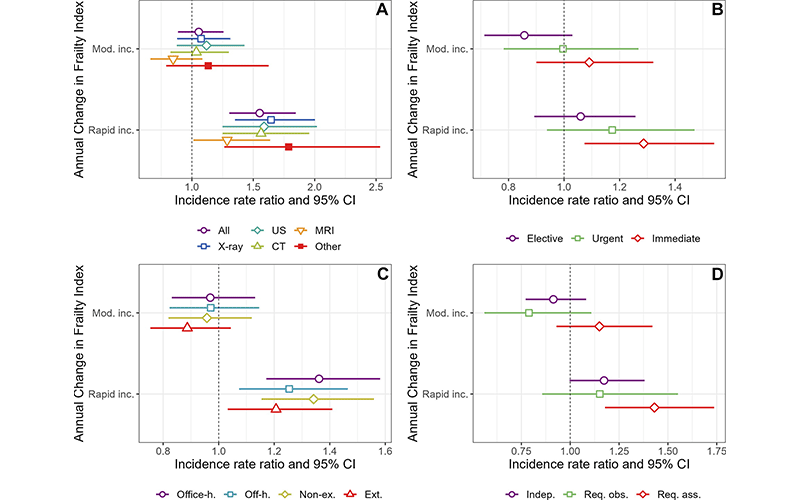Frail Patients Use More Imaging Services, Especially Those in Rapid Decline
The proportion of patients over the age of 65 is expected to double by 2050 and understanding factors that lead to increased imaging is important

RSNA News highlights the role radiology plays in supporting the imaging needs of the aging population. This is the third in a series of stories. Read the first and second story.
Aging patients who are characterized as frail may utilize medical imaging services at a rate double that of their peers—and may incur three times the cost, according to a Finnish longitudinal study.
Nearly 2,000 patients, a subset of participants in the Helsinki Birth Cohort Study, were assessed in late midlife and followed up for almost two decades to old age.
“We noted that those patients who were characterized as frail used approximately two times more imaging services, and their imaging-related costs were threefold higher, in comparison to the non-frail participants,” said Otso Arponen, MD, PhD, a resident physician and postdoctoral researcher at the Department of Radiology at Tampere University Hospital in Finland.
Dr. Arponen and the team investigated contributing factors to the utilization of radiologic services. The team’s work, published in Radiology, examined the association between frailty and the use of radiologic tests.
Frailty Can Affect Imaging Use
“We had a systematic approach when selecting variables for our frailty index in accordance with the standard procedure described in the BMC Geriatrics journal by Searle and colleagues,” Dr. Arponen said.
The researchers considered all available variables that were linked to “frail” status, including chronic diseases, functioning, laboratory results and medications. These variables typically showed an increasing prevalence across older ages and were common enough to be relevant for the study population.
“Additionally, it was important that the variable was not correlated too strongly with other variables and that it had low missingness—less than 10%,” Dr. Arponen explained.
The team found that, compared with participants who had a slow or stable change in frailty as they aged, patients who demonstrated a rapid increase in frailty used medical imaging services at a rate 1.82 times higher, regardless of their frailty score at baseline. Their costs were also 1.62 times higher.
“The patients who experienced a rapid increase in frailty were often older, female, and less frail at baseline,” Dr. Arponen said. “However, there were no socioeconomic differences between the groups.”

Graphs show incidence rate ratios (IRRs) of the use of medical imaging services during individual follow-up time in participants stratified by annual change in frailty index (reference group was stable or slow change in frailty). IRRs are stratified by (A) imaging modality, (B) urgency of imaging, (C) timing and extensiveness of imaging, and (D) functional status of the participant at imaging. Estimates are adjusted for age, sex, adult socioeconomic status, smoking status, frequency of alcohol use, and baseline level of frailty. Ext. = extensive imaging, inc. = increase, Indep. = independent, Mod. = moderate, Non-ex. = nonextensive imaging, Off-h. = off-hour imaging, Office-h. = office-hour imaging, Req. ass. = required assistance, Req. obs. = required observation. https://doi.org/10.1148/radiol.230283 ©RSNA 2023
Growing Imaging Needs Drive Higher Costs
In Finland, most health care is funded by a decentralized universal system, with patients paying small consultation fees or per-diem fees for hospitalization. As the quality of health care improves and patients live longer, associated costs may present new challenges for the society.
“We were surprised by the wide-ranging association between frailty and imaging service use,” Dr. Arponen said. “Indeed, those deemed frail used substantially more imaging services. Furthermore, those with the most rapid increase in frailty and the frailest participants used the imaging services the most.”
The researchers noted these increases applied to X-ray, US, CT and MRI examinations alike, without major differences between most anatomic target areas.
“Nevertheless, the use of head CT, abdominal ultrasound and spine MRI was higher among those with rapidly increasing frailty than among those with stable frailty.”
The authors acknowledged that, although they could account for major socioeconomic and lifestyle-related confounding factors, they can’t exclude the possibility of residual contributors, since the relationship between frailty and imaging services is likely multifactorial. They encouraged further research on how underlying indications for imaging, as well as different demographic and health care system characteristics, affect the use and cost of imaging in frail patients—and whether the cost and frequency of use could change the management of these patients.
For More Information
Access the Radiology study, “Frailty in Late Midlife to Old Age and Its Relationship to Medical Imaging Use and Imaging-related Costs: A Longitudinal Study."
Access the BMC Geriatrics study, “A standard procedure for creating a frailty index,” at bmcgeriatr.biomedcentral.com.
Read previous RSNA News stories on imaging of unique populations:
- Radiologists at the Frontline of Preventing Elder Abuse
- Lung Nodules Seen in a High Percentage of Non-Smokers
- Closing the Breast Cancer Screening Gap for Uninsured Patients